Related Research Articles
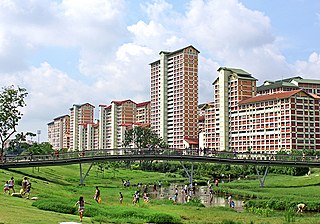
Public housing is a form of housing tenure in which the property is usually owned by a government authority, either central or local. Although the common goal of public housing is to provide affordable housing, the details, terminology, definitions of poverty, and other criteria for allocation vary within different contexts.
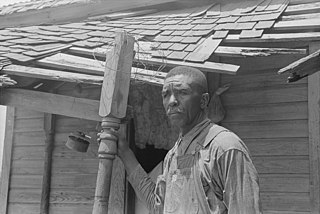
A tenant farmer is a person who resides on land owned by a landlord. Tenant farming is an agricultural production system in which landowners contribute their land and often a measure of operating capital and management, while tenant farmers contribute their labor along with at times varying amounts of capital and management. Depending on the contract, tenants can make payments to the owner either of a fixed portion of the product, in cash or in a combination. The rights the tenant has over the land, the form, and measures of payment vary across systems. In some systems, the tenant could be evicted at whim ; in others, the landowner and tenant sign a contract for a fixed number of years. In most developed countries today, at least some restrictions are placed on the rights of landlords to evict tenants under normal circumstances.

Sharecropping is a legal arrangement with regard to agricultural land in which a landowner allows a tenant to use the land in return for a share of the crops produced on that land.
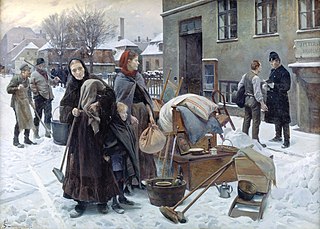
Eviction is the removal of a tenant from rental property by the landlord. In some jurisdictions it may also involve the removal of persons from premises that were foreclosed by a mortgagee.
A leasehold estate is an ownership of a temporary right to hold land or property in which a lessee or a tenant has rights of real property by some form of title from a lessor or landlord. Although a tenant does hold rights to real property, a leasehold estate is typically considered personal property.

Clonmany is a village in north-west Inishowen, in County Donegal, Ireland. The Urris valley to the west of Clonmany village was the last outpost of the Irish language in Inishowen. In the 19th century, the area was an important location for poitín distillation. Outside the village, there are a number of notable townlands, including Kinnea (Rockstown), Crossconnell, Dunaff, and Leenan.

A cottage, during England's feudal period, was the holding by a cottager of a small house with enough garden to feed a family and in return for the cottage, the cottager had to provide some form of service to the manorial lord. However, in time cottage just became the general term for a small house. In modern usage, a cottage is usually a modest, often cosy dwelling, typically in a rural or semi-rural location and not necessarily in England. The cottage orné, often quite large and grand residences built by the nobility, dates back to a movement of "rustic" stylised cottages of the late 18th and early 19th century during the Romantic movement.
The Land Acts were a series of measures to deal with the question of tenancy contracts and peasant proprietorship of land in Ireland in the nineteenth and twentieth centuries. Five such acts were introduced by the government of the United Kingdom between 1870 and 1909. Further acts were introduced by the governments of the Irish Free State after 1922 and more acts were passed for Northern Ireland.

State housing is a system of public housing in New Zealand, offering low-cost rental housing to residents on low to moderate incomes. Some 69,000 state houses are managed by Kāinga Ora – Homes and Communities, most of which are owned by the Crown. In excess of 31,000 former state houses exist, which are now privately owned after large-scale sell-offs during recent decades. Since 2014, state housing has been part of a wider social housing system, which also includes privately owned low-cost housing.

Toronto Community Housing Corporation (TCHC) is a public housing agency in Toronto, Ontario. It is the largest social housing provider in Canada with over 58,000 units across 2,100 buildings and approximately 105,000 residents. It is the second-largest housing provider in North America, behind the New York City Housing Authority.

The Irish Land and Labour Association (ILLA) was a progressive movement founded in the early 1890s in Munster, Ireland, to organise and pursue political agitation for small tenant farmers' and rural labourers' rights. Its branches also spread into Connacht. The ILLA was known under different names—Land and Labour Association (LLA) or League (LLL). Its branches were active for almost thirty years, and had considerable success in propagating labour ideals before their traditions became the basis for the new labour and trade unions movements, with which they gradually amalgamated.
In the late Roman Empire and the Early Middle Ages a colonus was a tenant farmer. Known collectively as the "colonate", these farmers operated as sharecroppers, paying landowners with a portion of their crops in exchange for use of their farmlands.

The Labour Party governed the United Kingdom of Great Britain and Northern Ireland from 1974 to 1979. During this period, Harold Wilson and James Callaghan were successively appointed as Prime Minister by Queen Elizabeth II. The end of the Callaghan ministry was presaged by the Winter of Discontent, a period of serious industrial discontent. This was followed by the election of Conservative leader Margaret Thatcher in 1979.
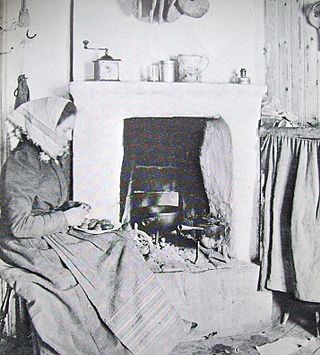
Statare were contract-workers in Swedish agriculture who, contrary to other farmhands, were expected to be married, were provided with a simple dwelling for their family, and instead of eating at the servants' table were paid in kind with foodstuff. They were, similarly to most other farmworkers, contracted on an annual basis. The family members' willingness to work, at some places unpaid, was taken for granted. This system became increasingly common during the 19th century, attracted much public critique in the 20th century, and was abolished from November 1, 1945 through a collective bargaining agreement.
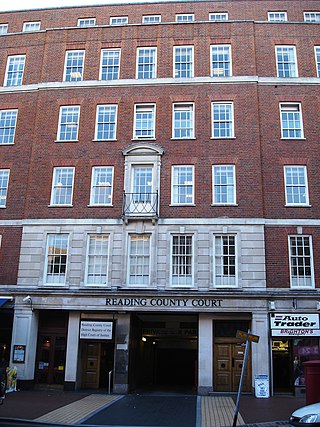
An assured tenancy is a legal category of residential tenancy to an individual in English land law. Statute affords a tenant under an assured tenancy a degree of security of tenure. A tenant under an assured tenancy may not be evicted without a reasonable ground in the Housing Act 1988 and, where periodic changes in rent are potentially subject to a challenge before a rent assessment committee.
The history of rent control in England and Wales is a part of English land law concerning the development of rent regulation in England and Wales. Controlling the prices that landlords could make their tenants pay formed the main element of rent regulation, and was in place from 1915 until its abolition by the Housing Act 1988.
Rent control in Scotland is based upon the statutory codes relating to private sector residential tenancies. Although not strictly within the private sector, tenancies granted by housing associations, etc., are dealt with as far as is appropriate in this context. Controlling prices, along with security of tenure and oversight by an independent regulator or the courts, is a part of rent regulation.

Public housing in the United Kingdom, also known as council housing or social housing, provided the majority of rented accommodation until 2011 when the number of households in private rental housing surpassed the number in social housing. Dwellings built for public or social housing use are built by or for local authorities and known as council houses. Since the 1980s non-profit housing associations became more important and subsequently the term "social housing" became widely used, as technically council housing only refers to housing owned by a local authority, though the terms are largely used interchangeably.

Housing in the United Kingdom represents the largest non-financial asset class in the UK; its overall net value passed the £5 trillion mark in 2014. Housing includes modern and traditional styles. About 30% of homes are owned outright by their occupants, and a further 40% are owner-occupied on a mortgage. About 18% are social housing of some kind, and the remaining 12% are privately rented.
A pre-regulation terraced house is a type of dwelling constructed before Public Health Act 1875. It is a type of British terraced house at the opposite end of the social scale from the aristocratic townhouse, built as cheap accommodation for the urban poor of the Industrial Revolution. The term usually refers to houses built in the century before the 1875 Act, which imposed a duty on local authorities to regulate housing by the use of byelaws. Subsequently, all byelaw terraced housing was required to meet minimum standards of build quality, ventilation, sanitation and population density. Almost all pre-regulation terraced housing has been demolished through successive waves of slum clearance.
References
- ↑ "Disempowerment of the working class: Tess of the d'Urbervilles" . Retrieved 14 December 2014.
- ↑ Brass, Tom (2011). Labour Regime Change in the Twenty-First Century: Unfreedom, Capitalism and Primitive Accumulation. BRILL. ISBN 9789004202474 . Retrieved 14 December 2014.
- ↑ Danziger, Renée (1988). Political Powerlessness: Agricultural workers in post-war England. Manchester University Press. ISBN 9780719026959 . Retrieved 14 December 2014.
- 1 2 Ross Clark (1 November 2003). "Tied cottage of the 21st century". Telegraph. Archived from the original on 14 December 2014. Retrieved 14 December 2014.
- ↑ "House of Commons debates, 1970" . Retrieved 14 December 2014.
- ↑ "Abolition of tied cottages". Parliamentary Debates (Hansard) . 19 June 1974. Retrieved 14 December 2014.
- ↑ "Abolition of tied cottages Bill". Parliamentary Debates (Hansard) . 19 June 1974. Retrieved 14 December 2014.
- ↑ Agricultural Dwelling House Advisory Committees in England (PDF). DEFRA. Retrieved 14 December 2014.
- ↑ Sparkes, Peter (2001). A New Landlord and Tenant. Bloomsbury. ISBN 9781847311726 . Retrieved 14 December 2014.
- ↑ "UK Government: Agricultural Dwellings Housing Advisory Committees" . Retrieved 14 December 2014.
- ↑ Ian Pigott (11 August 2010). "Tied cottages". Farmers Weekly i-space. Retrieved 14 December 2014.
- ↑ James Stephen (20 August 2014). "Clarity is vital as tied cottages come under tax scrutiny". Western Daily Press. Retrieved 14 December 2014.
- ↑ "Buying property with an agricultural tie". Country Life. 7 May 2010. Retrieved 14 December 2014.